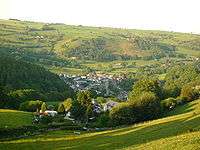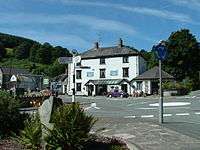Glyn Ceiriog
| (Llansantffraid) Glyn Ceiriog | |
 Centre of Glyn Ceiriog, view from the Glyn Valley Hotel |
|
 (Llansantffraid) Glyn Ceiriog |
|
| Population | 1,040 (2011)[1] |
|---|---|
| Language | British English |
| Welsh (48.3% of population)[2] | |
| OS grid reference | SJ205384 |
| Community | Llansanffraid Glyn Ceiriog |
| Principal area | Wrexham |
| Ceremonial county | Clwyd |
| Country | Wales |
| Sovereign state | United Kingdom |
| Post town | LLANGOLLEN |
| Postcode district | LL20 |
| Dialling code | 01691 |
| Police | North Wales |
| Fire | North Wales |
| Ambulance | Welsh |
| EU Parliament | Wales |
| UK Parliament | Clwyd South |
| Welsh Assembly | Clwyd South |
| Website | glynceiriog |
Coordinates: 52°56′13″N 3°10′59″W / 52.937°N 3.183°W
Glyn Ceiriog is the principal settlement of the Ceiriog Valley. Confusingly, Glyn Ceiriog translates simply as Ceiriog Valley, though there are other villages in the valley. The village is technically known, in traditional Welsh naming style, as Llansantffraid Glyn Ceiriog or sometimes Llansanffraid Glyn Ceiriog, which means church of St Fraid (the Welsh name of St Bridget) in the Ceiriog Valley, but it has come to be known simply as Glyn Ceiriog, or even Glyn for short. The name Llansanffraid is now more associated with other villages of the same name.
Glyn Ceiriog is a local government community in Wrexham County Borough in Wales. It is in the Clwyd South National Assembly for Wales constituency and Clwyd South parliamentary constituency.
A former slate mining village, it lies on the River Ceiriog and on the B4500 road, about 6 miles (10 km) west of Chirk. It is under three miles (5 km) as the crow flies (but much further by road due to the steep mountains) south of Llangollen.

Geography and administration
Civic history
Glyn Ceiriog was historically administered as the civil parish of Llansantffraid Glyn Ceiriog, ("St Ffraid's in the Ceiriog Valley"). From 1889 until 1974, Glyn Ceiriog was part of the administrative county of Denbighshire, which was divided into various rural districts. From 1895 to 1935, Glyn Ceiriog was in the Chirk Rural District, which merged in 1935 with Llansilin Rural District to form the Ceiriog Rural District. Glyn Ceiriog was in the Ceiriog Rural District from 1935 to 1974.
In 1974, Denbighshire was abolished as an administrative county, and Glyn Ceiriog was incorporated into the Glyndŵr District of the new county of Clwyd. Both of those were dissolved in 1996, and Glyn Ceiriog became a part of the new unitary authority of Wrexham County Borough, in which it currently remains.
Political representation
Today, Glyn Ceiriog is administered within Wrexham County Borough Council, a unitary authority created in 1996. Glyn Ceiriog is in the Ceiriog Valley ward, and has an Independent councillor.
Since 2011, Glyn Ceiriog has been represented at the National Assembly for Wales by Ken Skates, the Labour Party Assembly Member for Clwyd South.
Since 2010, Glyn Ceiriog has been represented in the Parliament of the United Kingdom by Susan Jones, the Labour Party Member of Parliament for Clwyd South.
Physical geography/Geology
Glyn Ceiriog is located in the Ceiriog Valley, a valley created by the River Ceiriog. Geologically, the area has Ordovician and Silurian strata. The soil is thin and peaty.
Village Resources
Glyn Ceiriog being the principal village for the Ceiriog Valley, it is home to many of the Valley’s resources,

• Village Post Office
• Cross Stores Village Shop
• Glyn Valley Hotel
• The Oak Y Dderwen
• Valley Doctors Surgery
• Valley Pharmacy
• Christian Centre
• Ceiriog Memorial Hall
• Llansanffraid Church

Industry
Glyn Ceiriog was once the home of extensive slate quarries. The Glyn Valley Tramway was built to take the slate to a wharf on the Shropshire Union Canal and later to sidings on the Great Western Railway line from Chester to Shrewsbury.
Although the valley does not have a primary industry any longer, there are a few recent and long standing manufacturing businesses supplying the valley and beyond.
Transport
Bus services are provided by Bryn Melyn, a subsidiary of GHA Coaches. Services operate to Llangollen via Chirk and to Llanarmon Dyffryn Ceiriog on service 64. Infrequent services on route 65 connect the village to Wrexham via Ruabon.
Rail services are available from Chirk, 5 miles away.
Notable residents
A number of Welsh literary figures have lived in or near Glyn Ceiriog. The 15th century Welsh poet Guto'r Glyn (1435-1493) is associated with Glyn Ceiriog. The 17th century Welsh poet Huw Morus (Eos Ceiriog: Ceiriog Nightingale) (1622 - 1709) was born and lived near Glyn Ceiriog. The Eisteddfod prize-winning poet and lexicographer, Rev. Robert Elis (Cynddelw) (1812-1875) was a Baptist minister at Glyn Ceiriog Independent Welsh Baptist Chapel, Seion, from 1838-1840. The Welsh novelist Islwyn Ffowc Elis spent most of his childhood on a farm near Glyn Ceiriog, although he was born in Wrexham. The actress Sarah Edwards was born in Glyn Ceirog in 1882. Additionally, Lancelot Hogben, an experimental zoologist and medical statistician, moved to the Ceiriog Valley in the late 1950s, and lived in Glyn Ceiriog at the time of his death in 1975.
Bibliography
- Dewi Parry Jones & Robert Owen Jones, "100 Years in the Valley - Y Glyn a Fu" (1998)
- Dewi Parry Jones & Robert Owen Jones, "100 Years in the Valley Volume II - Y Glyn a Fu" (1999)
References
- ↑ "Community population 2011". Retrieved 18 November 2015.
- ↑ 48.3% of persons aged 3 years or over living in Wrexham 019B (Super Output Area Lower Layer) said they understood Welsh in the 2001 Census http://nationalstatistics.gov.uk
External links
| Wikimedia Commons has media related to Glyn Ceiriog. |
